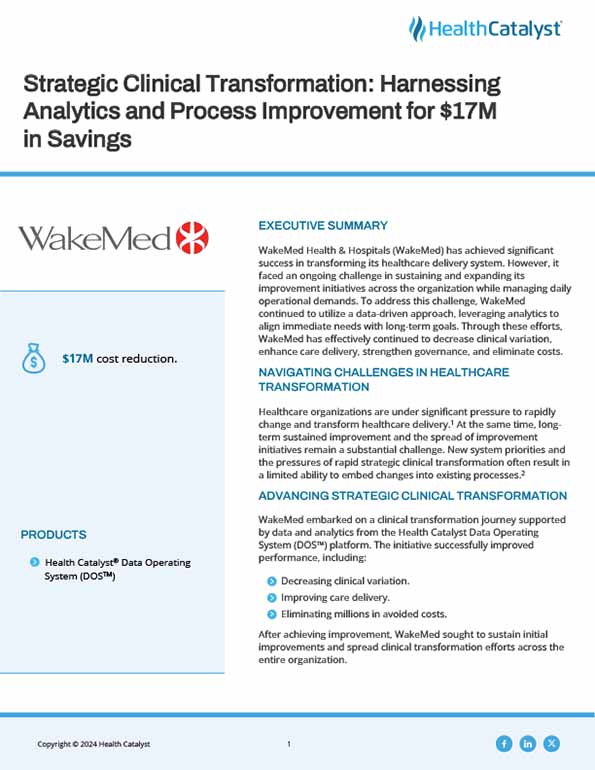WakeMed Health & Hospitals (WakeMed) has achieved significant success in transforming its healthcare delivery system. However, it faced an ongoing challenge in sustaining and expanding its improvement initiatives across the organization while managing daily operational demands. To address this challenge, WakeMed continued to utilize a data-driven approach, leveraging analytics to align immediate needs with long-term goals. Through these efforts, WakeMed has effectively continued to decrease clinical variation, enhance care delivery, strengthen governance, and eliminate costs.
Healthcare organizations are under significant pressure to rapidly change and transform healthcare delivery.1 At the same time, long-term sustained improvement and the spread of improvement initiatives remain a substantial challenge. New system priorities and the pressures of rapid strategic clinical transformation often result in a limited ability to embed changes into existing processes.2
WakeMed embarked on a clinical transformation journey supported by data and analytics from the Health Catalyst Data Operating System (DOS™) platform. The initiative successfully improved performance, including:
After achieving improvement, WakeMed sought to sustain initial improvements and spread clinical transformation efforts across the entire organization.
To further scale and sustain clinical transformation improvement efforts, WakeMed enhanced its clinical transformation structure to ensure comprehensive organizational alignment, implemented processes to support governance, and engaged more senior leadership in supporting improvement work and removing barriers impeding progress.
Using data from the DOS platform, WakeMed key stakeholders, including the chief clinical integration officer, chief medical information officer, senior vice president of quality, and process improvement leader, collaboratively identify improvement opportunities, make strategic decisions, and prioritize improvement opportunities.
WakeMed established clear improvement goals, including clinical targets for leaders and physicians to qualify for incentive compensation and aspirational improvement targets. The organization expanded its incentive program, making all providers eligible to receive incentives upon reaching the aspirational improvement targets.
WakeMed brought the data and analytics team and the process improvement team together, aligning efforts for maximum impact. The organization focuses on sustaining previous improvements, continuing to engage with improvement teams to review performance data and adjust processes where needed to further improve, and engaging with new stakeholders and teams to take on new improvement opportunities.
WakeMed shifted its focus, changing from primarily pursuing a wide breadth of improvement to pursuing opportunities with depth that are the most impactful to the organization and the patients it serves.
After implementing analytics applications that meet a variety of use cases, WakeMed is refining its applications to address specific use cases. The organization supports improvement teams that are independently using integrated data in numerous analytics applications to sustain gains and further accelerate improvements. It also supports teams that are learning how to make data-informed decisions and improving their analytics acumen.
Teams continue to use clinical excellence bundles—standardized evidence-based care pathways—to decrease unwarranted variation, improve care quality, and decrease costs. WakeMed continues to use Healthcare.AI to accelerate analytic insights and has integrated health equity data into its various analytics applications, enabling the identification of potential differences between groups of patients and the delivery of interventions to improve health equity.
WakeMed’s analytics-informed clinical transformation efforts continue to deliver results that positively impact patient outcomes and organizational performance. Select results include:
"We’re continually engaging more people in data-informed improvement, addressing some of the organization’s most pressing issues, decreasing costs, and improving performance."
- David Kirk, MD, Chief Clinical Integration Officer, WakeMed Health & Hospitals
WakeMed plans to strategically incorporate risk-adjusted observed versus expected data into its applications, enhancing its benchmarking capabilities and enabling a more precise prioritization of improvement opportunities. The organization is also engaging human resources and finance teams in using its process improvement methodology to improve operational performance further.


